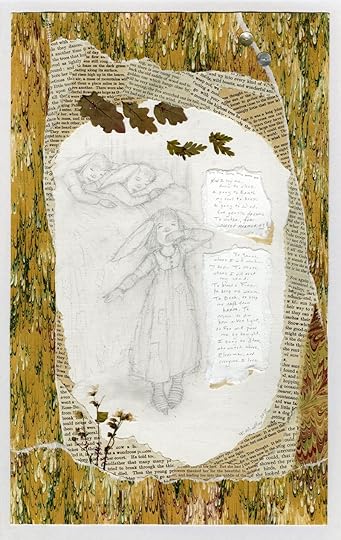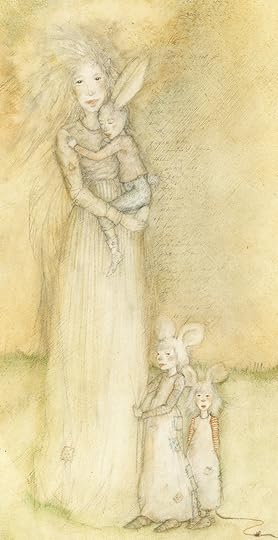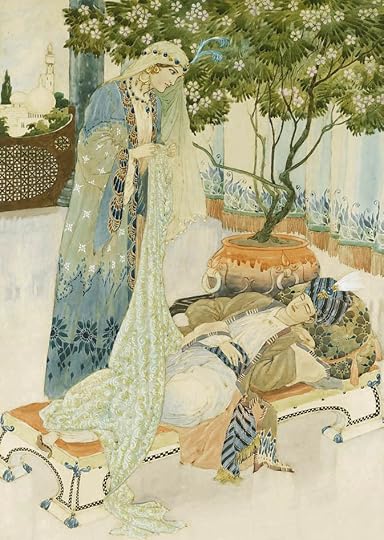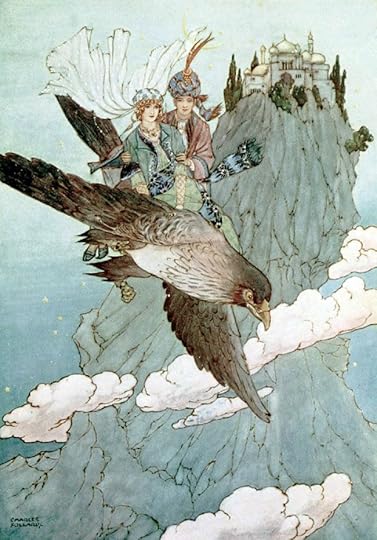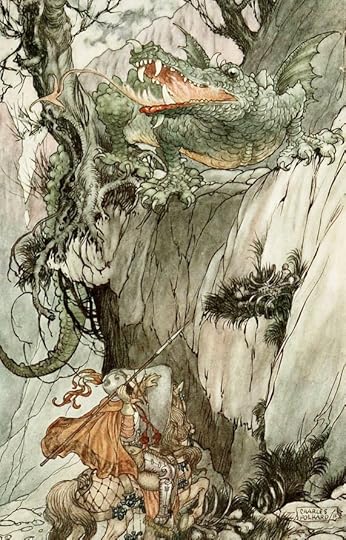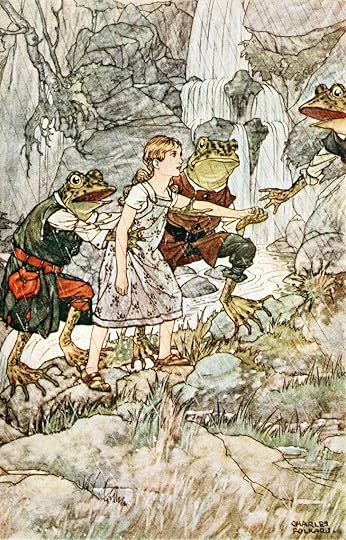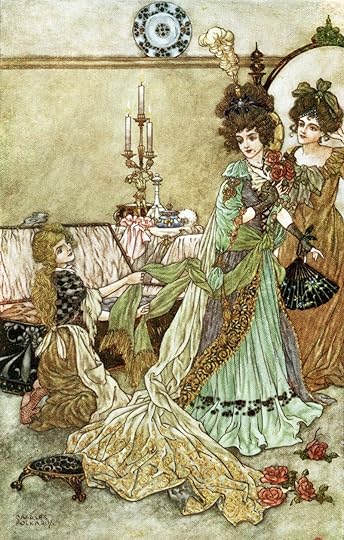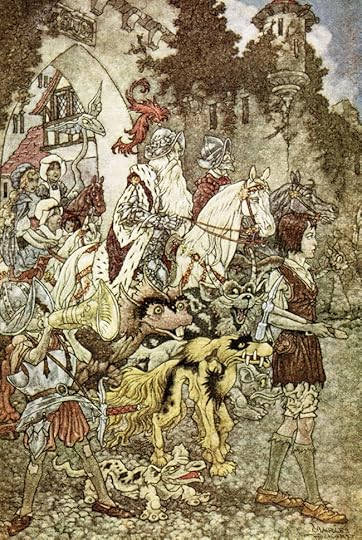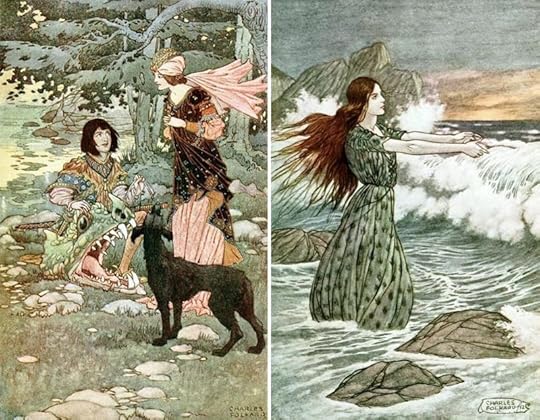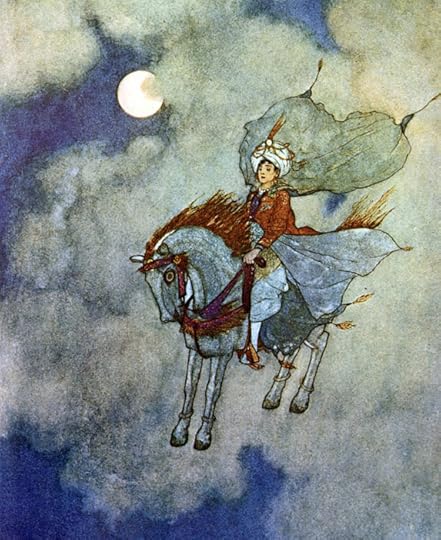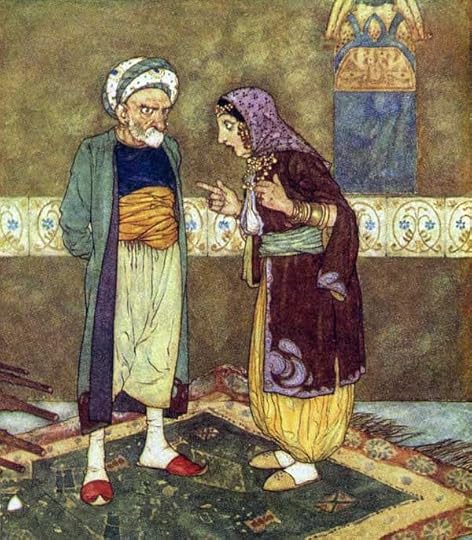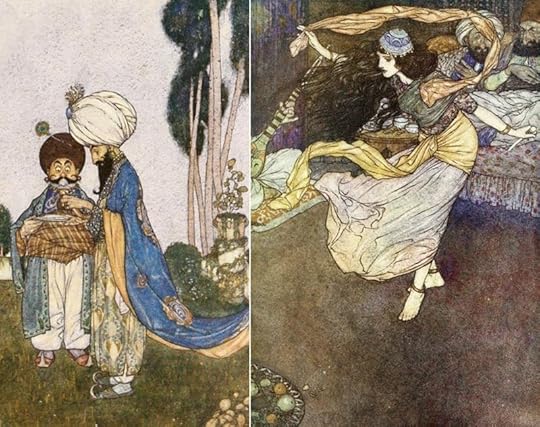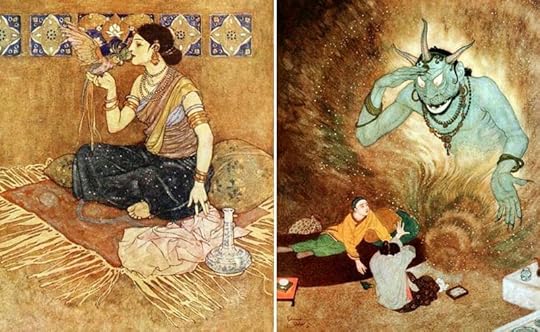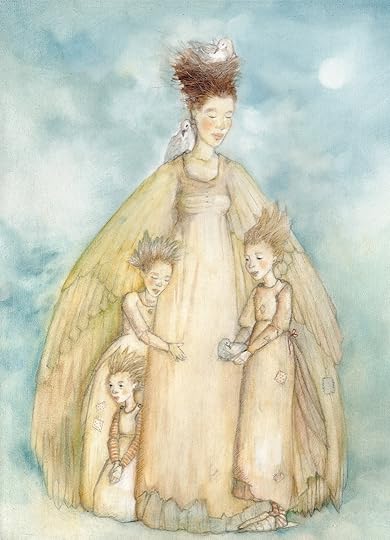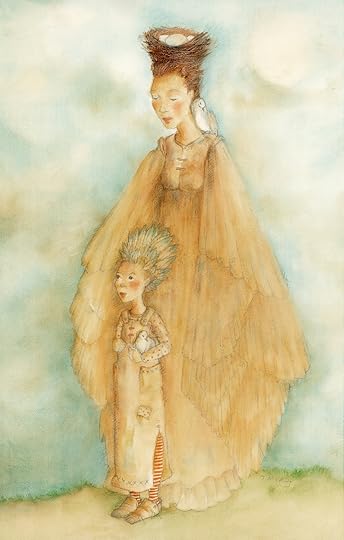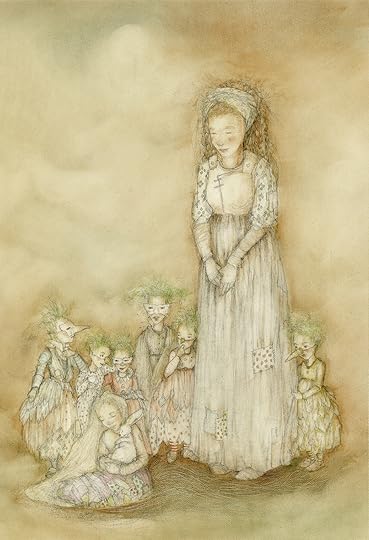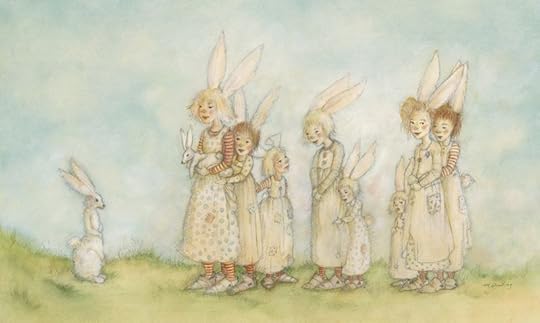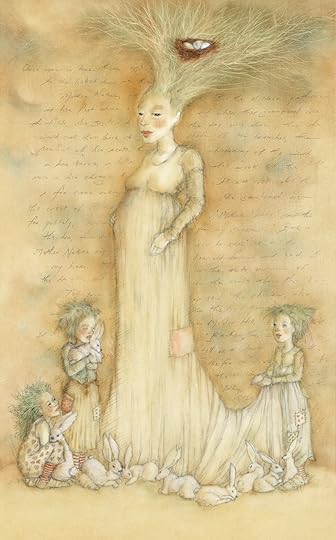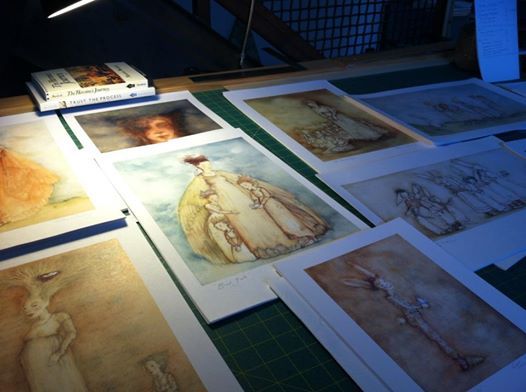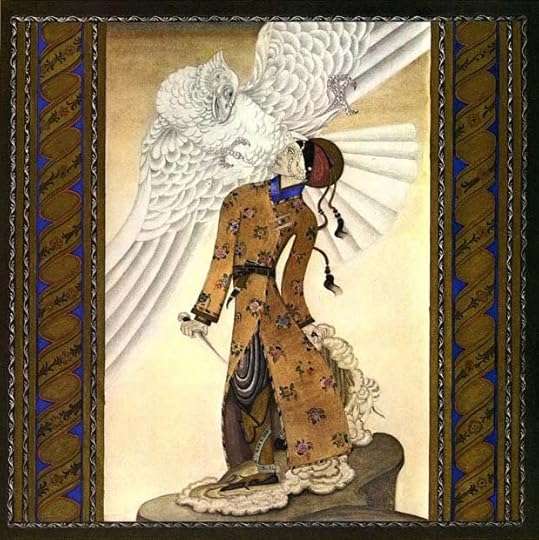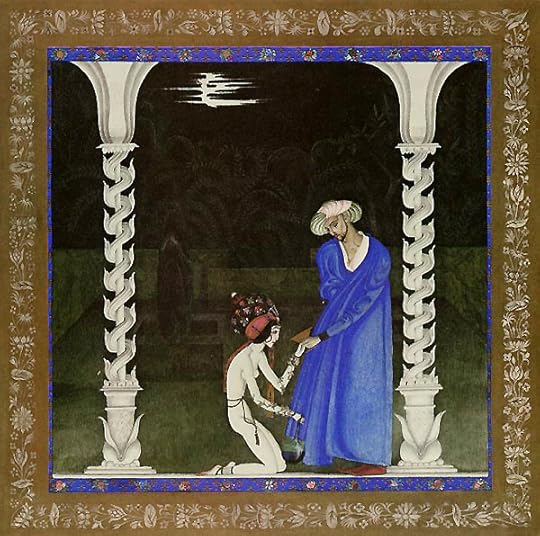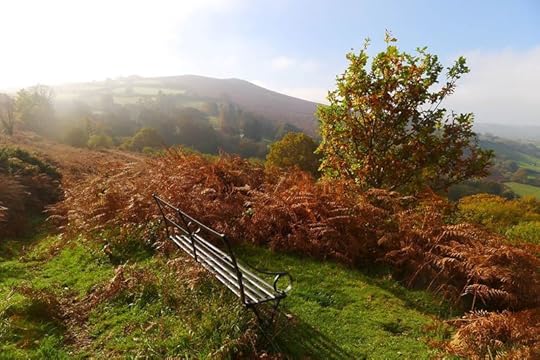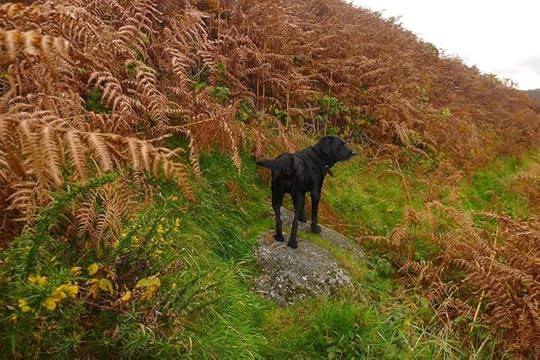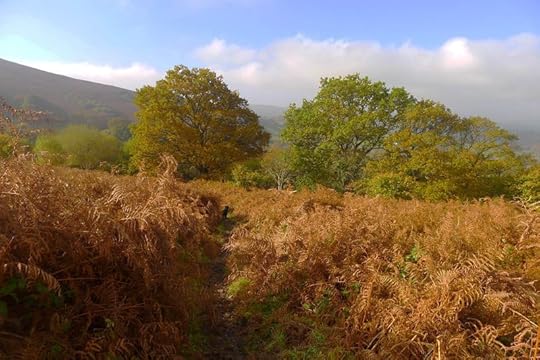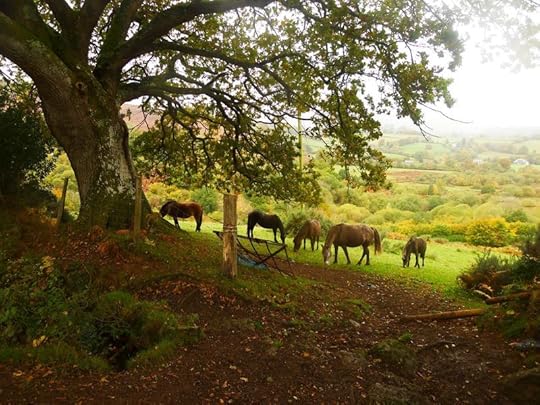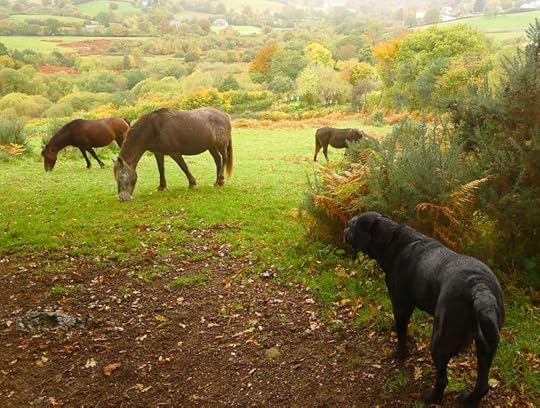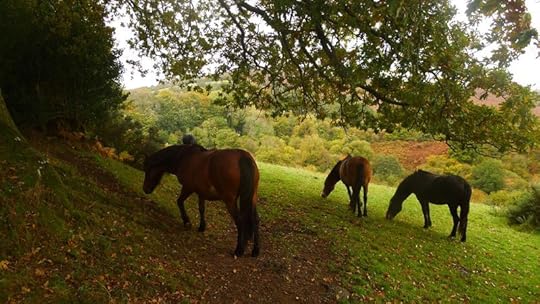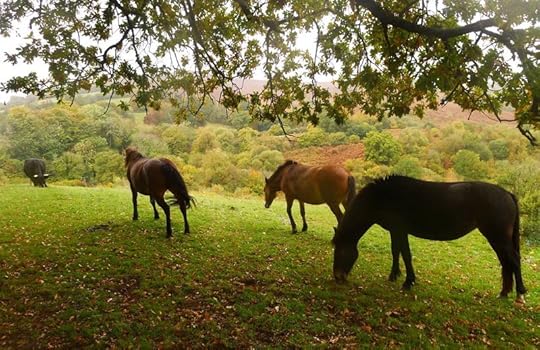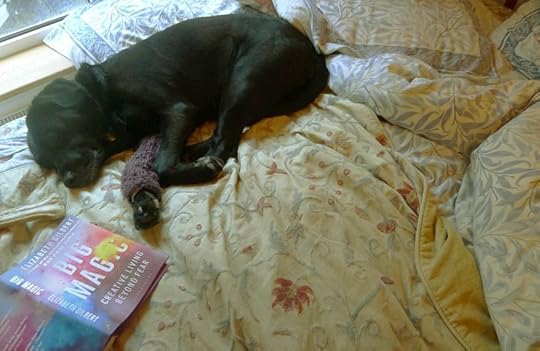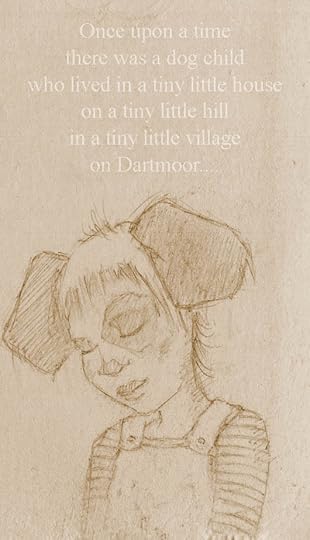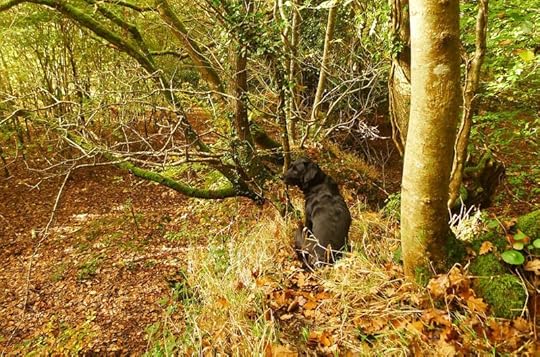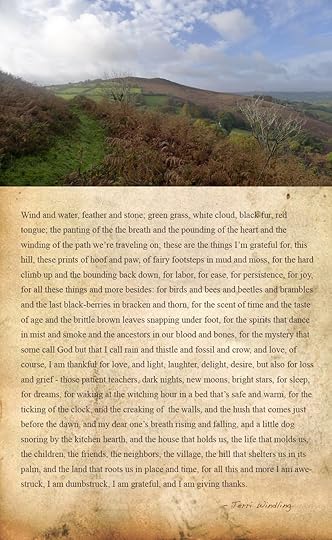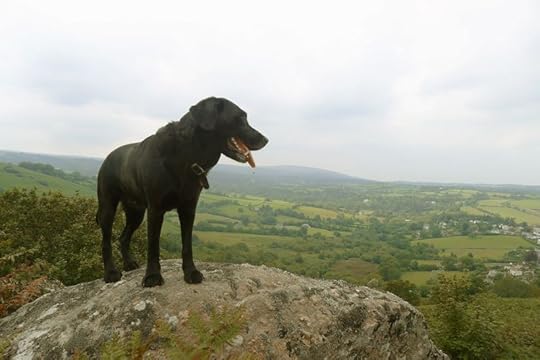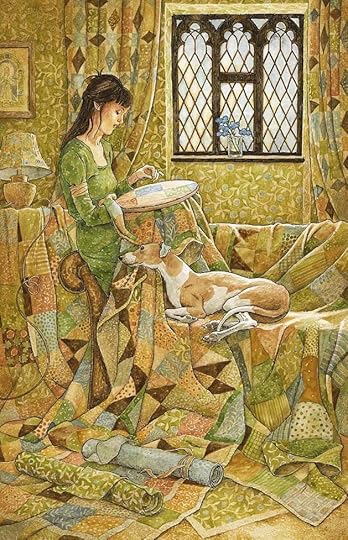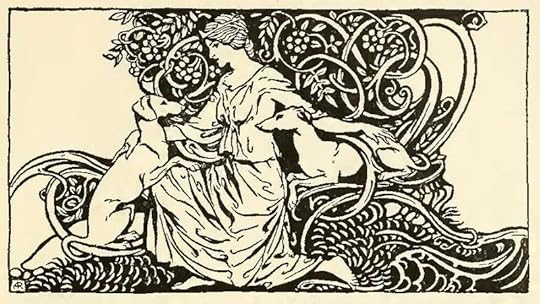Terri Windling's Blog, page 124
December 13, 2015
Last chance...
...to purchase original art by me and other Chagford artists from Fernie Brae Gallery's autumn show. There are orginal drawings and paintings by Brian Froud, David Wyatt, Rima Staines, and Danielle Barlow, plus limited edition Giclee prints by Virginia Lee and Marja Lee Kru��t. But the show is ending, so if you're interested, please contact the gallery right away.
The Fernie Brae is located in Portland, Oregon...but if you live elsewhere, they will ship the art to you. (And they also offer payment plans.) You can see the remaining work for sale here on Fernie Brae's Facebook page. The gallery's lovely website is here.
There are four pieces by me available, each of them pictured in this post: three hand-stitched collages (with pencil drawings, papers, fabrics, lace, buttons, and bits of Devon flora brought home from my walks with Tilly), and one of my "Earth Mother" paintings (oil paints and pencils on illustration board). If your budget doesn't run to original work, Fernie Brae also has signed prints of mine for sale; please contact them if you'd like more information. Also, Greta Ward is still kindly running her online sale of my prints (mailed out from her studio in Arizona), which will continue until the stock runs out.
May I ask you to please pass this information on to anyone who might be able to give these Little People of mine a good home? They want to go out into the world!
Now I Lay Me Down to Sleep
The piece includes a poem of mine, handwritten and stitched into the collage:
Now I lay me down to sleep,
I pray to Earth, my soul to keep.
I pray to Wind, for gentle dreams.
To Water, for sweet murmurings.
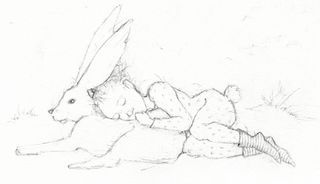 To Grass, where I will make my bed.
To Grass, where I will make my bed.
To Moss, where I will rest my head.
To blood���s Fire, to keep me warm.
To Dark, to keep me safe from harm.
To Moon, to dim her silver light
so Fox will pass me by tonight.
I pray to Stars, who watch above.
Bless me, and everyone I love.
Fairy Tales
The handwritten text says:
"Once upon a time there was a girl, there was a boy, there was a poor woman who wanted, there was a queen who couldn't have, there was witch who lived under, there was a green frog at the bottom of, there was a troll, a tree, a bear, a bright eyed bird who knew the secret of, there was a fairy who had lost, there was a child who had found, there was a wizard who had made, there was a princess who had broken, there was a story that was trying to be told. Listen. The wind is speaking...."
Earth Mother: Guardian of the Fields
I'm not going to tell you what the handwritten text says here, as it's not meant to be entirely decipherable. It's the story surrounding the Guardian and the little ones she protects...but I leave it to you to help tell her tale....
December 11, 2015
A trail of stories
Following up on yesterday's post: Another reason we hunger for narrative, writes Scott Russell Sanders in "The Power of Stories," is because stories create community.
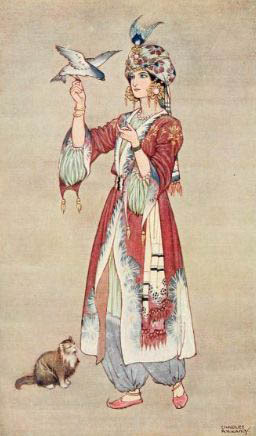 "They link tellers to listeners, and listeners to one another," he says. "This is obviously so when speaker and audience share the same space, as humans have done for all but the last few centuries of our million-year history, gathered around fires or huddled in huts; it is equally if less obviously so when we encounter our stories in solitude, on the page or screen. When two people discover they have both read Don Quixote, they immediately share a piece of history....Strangers who discover their mutual devotion to fairy tales or gangster movies or soap operas or Shakespeare's plays become thereby less strange to one another.
"They link tellers to listeners, and listeners to one another," he says. "This is obviously so when speaker and audience share the same space, as humans have done for all but the last few centuries of our million-year history, gathered around fires or huddled in huts; it is equally if less obviously so when we encounter our stories in solitude, on the page or screen. When two people discover they have both read Don Quixote, they immediately share a piece of history....Strangers who discover their mutual devotion to fairy tales or gangster movies or soap operas or Shakespeare's plays become thereby less strange to one another.
"Frank O'Connor went so far as to declare that 'the one subject a storyteller must write about' is 'human loneliness.' Whether or not stories speak to it directly, they offer us a relief from loneliness, by revealing that our most secret feelings and thoughts do not belong to us alone, by inviting us to join the circle of readers or listeners. The strongest bonds are formed by sacred stories, which unite entire peoples. Thus Jews rehearse the events of Passover; Christians tell of a miraculous birth and death and resurrection; Buddhists tell of Guatama meditating beneath a tree; the Hope recount the story of their emergence from the earth; the Aborigines repeat in song the primal deeds of their ancestors.
"As we know only too well, sacred stories may also divide the world between those who are inside the circle and those outside, between us and them, a division that has inspired pogroms and inquisitions and wars.
"There is danger in story, as in any great force. If the tales that captivate us are silly or deceitful, like most of those offered by television or advertising, they waste our time and warp our desires. If they are cruel they make us callous. If they are false and bullying, instead of drawing us into a thoughtful community they may lure us into an unthinking herd or, worst of all, into a crowd screaming for blood -- in which case we need other, truer stories to renew our vision. So The Diary of Anne Frank and Primo Levi's Survival in Auschwitz are antidotes to Mein Kamp. So Ralph Ellison's Invisible Man and Toni Morrison's Beloved are antidotes to the paranoid yarns of the Ku Klux Klan. So the patient exchange of stories between people searching for common ground is an antidote to the hasty sloganeering and slandering of talk shows."
"We are creatures of instinct," Sanders writes later in the essay, "but not soley of instinct. More than any other animal we must learn to behave. In this perennial effot, as Ursula Le Guin says, 'Story is our nearest and dearest way of understanding our lives and finding our way onward.' Skill is knowing how to do something; wisdom is knowing when and why to do it, or to refrain from doing it. While stories may display skill aplenty, in technique or character or plot, what the best of them offer is wisdom. They hold a living resevoir of human possibilities, telling us what has worked before, what has failed, where meaning and purpose and joy might be found.
"At the heart of many a tale is a test, a puzzle, a riddle, a problem to solve; and that, surely, is the condition of our lives, both in detail -- as we decide how to act in the present moment -- and in general, as we seek to understand what it all means. Like so many characters, we are lost in a dark wood, a labyrinth, a swamp, and we need a trail of stories to show us the way back to our true home."
The paintings today are by Charles Folkard (1878-1963), who was born in south London and worked as stage magician before turning his hand to design and illustration. He created Britain's first daily newpaper cartoon strip (The Adventures of Teddy Tail), but he's best known today for his long career as a children's book illustrator, producing sumptuous editions of fairy tales, nursery rhymes, Aesop's Fables, Alice in Wonderland, Pinnochio, The Princess and Curdie, and numerous other classics. Folkard died at the age of 85, still painting right up to the very end.
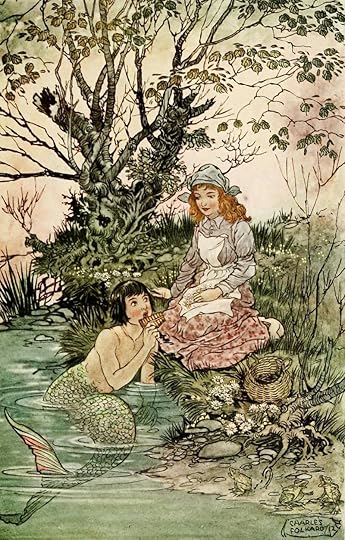 The passage above is from "The Power of Stories" by Scott Russell Sanders, published in his essay collection The Force of Spirit (Beacon Press, 2000), which is highly recommended. All rights reserved by the author.
The passage above is from "The Power of Stories" by Scott Russell Sanders, published in his essay collection The Force of Spirit (Beacon Press, 2000), which is highly recommended. All rights reserved by the author.
December 10, 2015
The hunger for narrative
In his great essay "The Power of Stories," Scott Russell Sanders explores ten primary reasons for telling and hearing stories. The first reason on his list is a simple one: Because they entertain us.
"Why else," he asks, "do we trade them so avidly, in myths and folktales, in poems and songs, movies and plays, novels and yarns, and countless other forms? Children tell stories spontaneously, exuberantly, even before they have enough words to fill out their sentences. Anyone who has made up a story for a child , or read one from a book, only to have the child beg for it again and again, night after night, knows that the need for story goes deep in us. Scheherazade kept a sultan from putting her to death by telling him stories, always breaking off in the middle of a plot at bedtime, leaving him eager for the next installment. You do not have to be a child or a bored sultan to hunger for stories, of course, nor a captive to be saved by them. We all hunger for narrative, from the simplest anecdote or joke to the most convoluted saga, as we hunger for bread or companionship or sunlight; and we all may be fed, and even restored, by a tale that speaks to our condition."
Sanders goes on to note: "In all its guises, from words spoken and written to pictures and musical notes and mathmatical symbols, language is our distinguishing gift, our hallmark as a species. We delight in stories because they are a playground for language, an arena for exercising this extraordinary power. The spells and enchantments that figure in so many tales remind us of the ambiguous potency of words, for creating or destroying, for binding or setting free. Italo Calvino, a wizard of storytelling, described literature as 'a struggle to escape from the confines of language; it stretches out from the utmost limits of what can be said; what stirs literature is the call and attraction of what is not in the dictionary.' Calvino's remark holds true, I believe, not just for the highfalutin modes we label as literature, but for every effort to make sense of our lives through narrative."
The full essay can be found in Sander's essay collection The Force Spirit, and is highly recommended.
The art today is from a 1911 editon of The Stories of the Arabian Nights, illustrated by Edmund Dulac.

Edmond Dulac was born and raised in Toulouse, France, where he spent two miserable years studying law before embracing art as his true vocation; he then studied at the ��cole des Beaux-Arts in Toulouse and the Acad��mie Julien in Paris before moving to London in 1904. Obtaining his first illustration commission (for Charlotte Bront��'s Jane Eyre) at the age of 22, Dulac went on to become of one of the greatest book illustrators of his day, while also collaborating on various theatre projects (usually with his friends W. B. Yeats and Thomas Beecham) and becoming an expert in postage stamp design. He spent the rest of his life in England (changing the spelling of his name from Edmond to Edmund), became a British citizen in 1914, and continued to create his exquisite illustrations right up to his death in 1953.
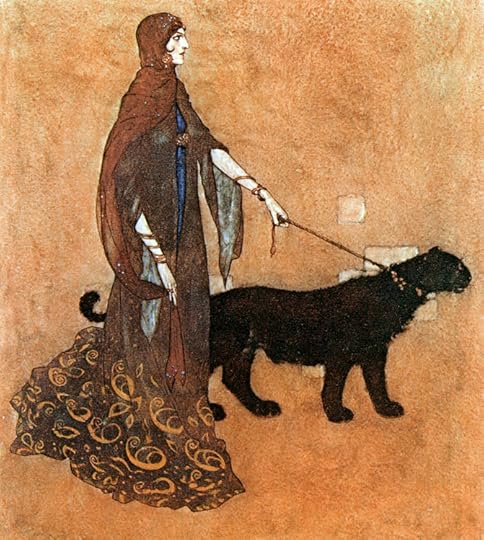 The passage above is from "The Power of Stories" by Scott Russell Sanders, published in his essay collection The Force of Spirit (Beacon Press, 2000); all rights reserved by the author.
The passage above is from "The Power of Stories" by Scott Russell Sanders, published in his essay collection The Force of Spirit (Beacon Press, 2000); all rights reserved by the author.
December 8, 2015
Little People looking for good homes....
Once again, my lovely friend Greta Ward is kindly making my prints available for purchase through her website ... and because she mails prints out once a week (from Tucson, Arizona), there's still time to order prints in time for Christmas, especially for those of you in the States. All the prints are hand-signed, and will remain on sale until the stock runs out. You'll find the prints here: http://gretaward.com/terri.
And while you're on Greta's site, please go have a look at her extremely gorgeous artwork too.
If you know anyone who might like to own one of my prints, would you please let them know about this sale? I have an ulterior motive for trying to sell as many of them as I possibly can this year: the proceeds will allow me the time to make more art, and I'm very eager to get back to the drawing board. Print purchases also help to support Myth & Moor...and to keep Tilly well stocked with bones!
This is true for just about every artist who isn't independently wealthy, of course, so please consider supporting writers, artists, musicians, and craftspeople when you're shopping for holiday gifts this year. I'm going to put a few links and suggestions in the Comments section below; please feel free to add suggestions and links of your own, including your own work.
The Lost Child
She had fallen out of her nest long ago and had no idea where she belonged. "Nevermind," the Bird Mother said, folding soft wings around the child. "We are your family now, so dry your tears. What was lost is found."
The Dreaming
Wrapped in the quilt, she closed her eyes and dreamed herself into a different story. The bunny snored softly in her arms. The wind pulled at her long yellow hair. Then she heard the rustle of footsteps...and the sound of giggling close behind her....
Best Friends
They were the best of friends, inseparable, and they spoke the same language: the language of the soul.
Bunny Troupe
"Thank you for coming," the rabbit said, paws crossed politely on his belly. Mina gazed at the stranger curiously and waited for him to tell his story. She'd never met such a creature before! He had only one shape, the animal shape. He couldn't 'shift' like them. Imagine!
Mother Nature
This Mother Nature is is a muse figure, and the symbol of a fecund imagination. The original painting used to hang above my writing desk to keep my creativity fresh and fertile...before she found a new home with another artist. May she bless your creativity as well.
***
There will be some new prints coming up in early next year too, just as soon as health permits. More on that anon. If it's original work you're after, the Fernie Brae Gallery in Portland, Oregon has three of my collages and one of my paintings (among other magical things), and they do ship.
December 7, 2015
Spinning stories with Scheherazade
"What's your story?" asks Rebecca Solnit in her exquisite memoir, The Faraway Nearby, which I've recently re-read. "It's all in the telling. Stories are compasses and architecture; we navigate by them, we build our sanctuaries and our prisons out of them, and to be without a story is to be lost in the vastness of a world that spreads in all directions like arctic tundra or sea ice. To love someone is to put yourself in their story, or figure out how to tell yourself their story.
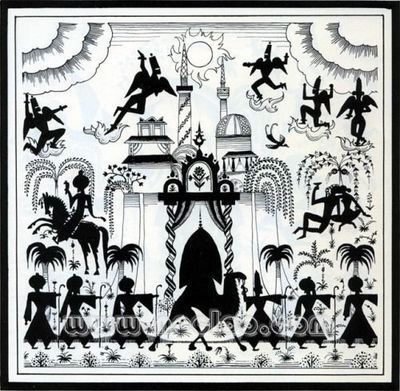 "Which means that a place is a story, and stories are geography, and empathy is first of all an act of imagination, a storyteller's art, and then a way of traveling from here to there. What is like to be the old man silenced by a stroke, the young man facing the executioner, the woman walking across the border, the child on the roller coaster, the person you've only read about, or the one lying next to you in bed?
"Which means that a place is a story, and stories are geography, and empathy is first of all an act of imagination, a storyteller's art, and then a way of traveling from here to there. What is like to be the old man silenced by a stroke, the young man facing the executioner, the woman walking across the border, the child on the roller coaster, the person you've only read about, or the one lying next to you in bed?
"We tell ourselves stories in order to live, or to justify taking lives, even our own, by violence or by numbness and the failure to live; tell ourselves stories that save us and stories that are the quicksand in which we thrash and the well in which we drown, stories of justification, of accursedness, of luck and starcrossed love, or versions clad in the cynicism that is at times a very elegant garment. Sometimes the story collapses, and it demands that we recognize we've been lost, or terrible, or ridiculous, or just stuck; sometimes change arrives like an ambulance or supply drop. Not a few stories are sinking ships, and many of us go down with these ships even when the lifeboats are bobbing around us.
"In The Thousand and One Nights, known in English as The Arabian Nights, Scheherazade tells stories in order the keep the sultan in suspense from night to night so he will not kill her. The backstory is that the sultan caught his queen in the embrace of a slave and decided to sleep with a virgin every night and slay her every morning so that he could not be cuckolded again. Scheherazade volunteered to try to end the massacre and did so by telling him stories that carried over from one night to the next for nights that stretched into years.
"She spun stories around him that kept him in a cocoon of anticipation from which he eventually emerged a less murderous man. In the course of all this telling she bore him three sons and delivered a labyrinth of stories within stories, stories of desire and deception and magic, of transformation and testing, stories in which the action in one freezes as another storyteller opens his mouth, pregnant stories, stories to stop death.
"We think we tell stories, but stories often tell us, tell us to love or to hate, to see or to be blind. Often, too often, stories saddle us, ride us, whip us onward, tell us what to do, and we do it without questioning. The task of learning to be free requires learning to hear them, to pause and hear silence, to name them, and then to become the storyteller. Those ex-virgins who died were inside the sultan's story; Scheherazade, like a working-class hero, seized control of the means of production and talked her way out."
The paintings and drawing here are by the great Danish artist Kay Rasmus Nielsen (1886-1957), best known for East of the Sun, West of the Moon and other sumptuously illustrated fairy tale editions. These pictures were created sometime around 1917 for an edition of The Arabian Nights translated by Arabic scholar Arthur Christensen...but the project never came to fruition and the paintings remained unknown and unpublished until after the artist's death.
The Paris Review has just published a short article on Nielsen on their website, with a number of his gorgeous fairy tale illustrations. (I feel a childlike delight in the serendipity of the posting, which appeared on my birthday.) You can learn more about his fascinating but tragic life in "From Fairy Tales to Fantasia," an article of mine in the Journal of Mythic Arts archives (2001).
For Arabian Nights illustrations by a range of other artists, see Maria Popova's "A Visual History of the Arabian Nights" (The Atlantic, 2012).
And to learn more about Scheherazade and her tales, I recommend Marina Warner's excellent book Stranger Magic: Charmed States & the Arabian Nights (Viking, 2013).
 The passage above is from The Faraway Nearby by Rebecca Solnit (Viking, 2013), all rights treserved.
The passage above is from The Faraway Nearby by Rebecca Solnit (Viking, 2013), all rights treserved.
Music for a Monday Morning
Many years ago in my adolescence in a small industrial city in Pennyslvania, I came across a record in a second-hand shop by a band with the strange name of Steeleye Span. This was in the 1970s: not only pre-Internet, but also before shopping malls and big chain music stores or any other means of easy access to music other than the Top Ten hits of pop radio...so how on earth an English folk album ended up in a charity stop in a rough, declining Pennsylvania steel town I can't even imagine. The record looked interesting and cost almost nothing, so I took it home and gave it a try...and then played it over and over again (probably to the annoyance of everyone else in our crowded little house) while attempting to track down information and other albums by the band. (Again, not easy pre-Internet.)
Pleased to See the King by Steeleye Span was my introduction to folk balladry and the beginning of a life-long love affair with the folk music, lore, and literature of the British Isles...which is not, I think, an uncommon story among fantasy writers, artists, and readers of my generation. So today, here's some lovely music from the band that started it all off for me and for so many us.
Steeleye Span was formed in 1969, continued to perform (with a shifting mix of members) through all the ups and downs of the decades that followed, and is still making music rooted in the folk tradition almost half a century later.
Above: Steeleye Span way back in the early '70s, recorded for a BBC television program. The singers are Maddy Prior and Martin Carthy (oh my gracious, how young they look here!), with Peter Knight on fiddle, Ashley Hutchings on bass, and Tim Hart (1948-2009) on dulcimer. "The Lark in the Morning" is a traditional English folk song collected by Ralph Vaughan Williams in 1904. This version appeared on Pleased to See the King, Steeleye Span's second album, in 1971.
Below: "Cam ye o' frae France," a song about the Jacobite Revolution in Scotland in the 18th century. It appeared on the band's fifth album, Parcel of Rogues, in 1973 -- but this performance was filmed at Beck Theatre in Middlesex in 1989. (To read the lyrics, go here.)
The members of Steeleye Span went on to create many other musical projects over the years, such as The King of Elfland's Daughter by Bob Johnson & Peter Knight (1977), inspired by the fantasy novel by Lord Dunsany; Maddy Prior's two Silly Sisters albums in collaboration with June Tabor (1976, 1988); Martin Carthy's The Moral of the Elephant, in collaboration with his daughter Eliza (2014); and Peter Knight's three albums with his folk/jazz trio Gigspanner (to name just a few), as well as fine solo albums by all of these musicians. Gigspanner has a terrific new album out this year, so the next two songs are theirs.
Above: The wonderfully eerie music video for "Death and the Lady" by Gigspanner, from Layers of Ages (2015). The song is a traditional ballad collected by Francis Collison in 1946, published in The Penguin Book of English Folk Songs by Ralph Vaughan Williams & A.L. Lloyd. The tune is taken from the singing of Norma Waterson (A Dark Light, 2002).
Below: A powerful video by Perrine Nouvier for "Hard Times of Old England" by Gigspanner. This classic 18th century song has also been recorded by Steeleye Span, Jon Boden, and Imagined Village (with Billy Bragg), among others...and seems, alas, all too pertinent today under the current UK government.
Since that last song was a heart-breaker, let's end today today with a glimmer of light:
Below, a brand new video by Steeleye Span for "Somewhere Along the Road" -- a song written by Rick Kemp and recorded for their latest album, The Essential Steeleye Span (2015). This video warms my heart because it reminds me of winter gatherings around the table with my own circle of friends, toasting the seasons s as the years go by...growing older, greyer, slower, yes, but maybe a little wiser too. And still making art rooted in the folk tradition after all these years.
As Charles Vess reminded me recently, Rob Young's book Electric Eden is a fascinating history of folk and folk-rock music Britain. A previous post on the book is here.
December 4, 2015
Big Magic
Even illness has its gifts -- and the most precious of them (as I've noted in a previous post) is the time to read, which brings me treasures I might have missed in the busy-ness of ordinary life. Of the books I've devoured during this recent round of illness, there's one I now find myself recommending to just about everyone I know: Big Magic by Elizabeth Gilbert, a guide to creative writing and creative living.
Big Magic is written in a breezy, conversational style, but there is true wisdom underlying Gilbert's deliberately populist approach to the subject of creativity, presented in a generous and open-hearted manner, but also with no punches pulled. Her ideas about inspiration are colored by myth and mysticism, drawing on the Greco-Roman concept of creative genius as a force outside ourselves with whom we collaborate (as we've explored here in posts on the work of Lewis Hyde, among others), so it's not a book I'd recommend to hardcore cynics. I'm assuming, however, that Myth & Moor readers are likely to be open to a bit of myth, magic, and enchantment. If you struggle with your creative work at all (and perhaps even if you don't), please consider giving Gilbert's delightful and insightful book at try.
Here's a taste of Big Magic, from a chapter on the concept of "creative permission" (another subject we've talked about here before):
"You do not need anybody's permission to live a creative life," Gilbert states emphatically. "Maybe you didn't receive this kind of message growing up. Maybe your parents were terrified of risk in any form. Maybe your parents were obsessive-compulsive rule-followers, or maybe they were too busy being melancholic depressives, or addicts, or abusers to ever use their imaginations towards creativity. Maybe they were afraid of what the neighbors would say. Maybe your parents weren't makers in the least. Maybe you grew up in an environment where people just sat around watching TV and waiting for stuff to happen to them. Forget about it. It doesn't matter.
"Look a little further back in your family's history. Look at your grandparents: Odds are pretty good they were makers. No? Not yet? Keep looking back, then. Go back further still. Look at your great-grandparents. Look at your ancestors. Look at the ones who were immigrants, or slaves, or soldiers, or farmers, or sailors, or the original people who watched the ships arrive with strangers on board. Go back far enough and you will find people who were not consumers, people who were not sitting around passively waiting for stuff to happen to them. You will find people who spent their lives making things. This is where you come from. This is where we all come from.
"Human beings have been creative beings for a really long time -- long enough and consistently enough that it appears to be a totally natural impulse...[and] the diversity in our creative expression is fantastic. Some of the most enduring and beloved artwork on earth is unmistakably majestic. Some of it makes you want to drop to your knees and weep. Some of it doesn't, though. Some acts of artistic expression might stir and excite you, but bore me to death. Some of the art that people have created across the centuries is absolutely sublime, and probably did emerge from a grand sense of seriousness and sacredness, but a lot of it didn't. A lot of it is just folks messing around for their own diversion -- making their pottery a little prettier, or building a nicer chair, or drawing penises on the walls to pass the time. And that's fine too.
"You want to write a book? Make a song? Direct a movie? Decorate pottery? Learn to dance? Explore a new land? You want to draw a penise on your wall? Do it. Who cares? It's your birthright as a human being, so do it with a cheerful heart. (I mean, take it seriously, sure -- but don't take it seriously.) Let inspiration lead you wherever it wants to lead you. Keep in mind that for most of history people just made things, and they didn't make such a freaking deal out of it.
"We make things because we like making things."
"If you're alive, you're a creative person," Gilbert continues. "You and I and everyone you know are descended from tens of thousands of years of makers. Decorators, tinkerers, storytellers, dancers, explorers, fiddlers, drummers, builders, growers, problem-solvers, and embellishers -- these are our common ancestors.
"The guardians of high culture will try to convince you that the arts belong only to a chosen few, but they are wrong and they are also annoying. We are all the chosen few. We are all makers by design. Even if you grew up watching cartoons in a sugar stupor from dawn to dusk, creativity still lurks within you. Your creativity is older than you are, older than any of us. Your very body and your very being are perfectly designed to live in collaboration with inspiration, and inspiration is still trying to find you -- the same way it hunted down your ancestors.
"All of which is to say: You do not need permission from the principal's office to live a creative life."
Indeed.
December 3, 2015
The Dog Child's Tale
Dear Readers,
Thank you for your patience while I've been recovering from a yet another round of illness. I'm finally getting back on my feet ... a little slowly, a little shakily, yes, but I'm determined to be well again, and I'm a very stubborn woman. As a new month commences, and a new year begins (for me, anyway, because today's my birthday), it's time to get back to the studio, back to writing, back to art, and back to Myth & Moor.
I know some people cringe at the thought of getting another year older, but I'm not one of them. Having once been told by doctors that I'd be lucky to make it to the age of 20, reaching middle age and moving towards old age is a daily thing of wonder. I've written down my thoughts on mid-fifties birthdays before (they're here if you want to read them), so today I offer this instead:
In some indigenous cultures it's traditional to give gifts, not receive them, on the day of one's birth...as an act of gratitude to the spirits and the ancestors, as well as to family and community, for the miraculous gift of life and all that makes our lives worthwhile. So this "Dog Child" today is my gift to all of you. Please feel free to download the drawing and print it out if you wish. Her story begins Once Upon a Time....
I leave it to each of you to decide where the tale might go from here.
November 26, 2015
Giving Thanks
I'm also thankful for you, dear Readers, and the whole mythic arts community.
To those of you in America: Have a warm and peaceful Thanksgiving weekend, full of good talk, good food, loud laughter, quiet moments, and of all of the ancient, mythic, magical, noncommercial things that matter the most. And to those of you in the rest of the world, I wish the very same.
I hope to be back to the studio (and Myth & Moor) sometime next week, if all goes well. Fingers crossed.
November 19, 2015
Recommended Reading
The bug that I'm down with is still going strong, so I can't yet predict when I'll be back in the studio. In the meantime, here's some recommended reading for you while I'm away...
"A Conversation with Phillip Pullman" (Slate Book Review).
"An Interview with Jenny Diski" by Robert Hanks (The Guardian).
"Witches Brew: Patti Smith's M Train" by Evelyn McDonnell (Los Angeles Review of Books).
"The Books" by Alexander Chee (The Morning News).
"Writers, we need to stop saying this" by J.H. Moncrieff (blog post).
"Paint by Gender: The Shoes Under the Art World" by Pat Lipsky (The Awl).
"Why are Old Women Often the Face of Evil in Fairy Tales and Folklore" by Elizabeth Blair (NPR Books).
"Richard Dadd: the art of a 'criminal lunatic' murderer" (and fairy painter), by Paul Kerley (BBC Magazine).
"The Greatness of William Blake" by Richard Holmes (The New York Review of Books).
"Salthouse Marshes" by Robert Macfarlane and Adam Scovell (Caught by the River).
"Finding Time" by Rebecca Solnit (Orion).
"HS2: The Human Cost" by Patrick Barkham (The Guardian).
"In the Eyes of a Bear" by Julian Hoffman (Zoomorphic -- a fine new magazine dedicated to wildlife and the more-than-human world).
"In Search of the Mountain Ghost" by Katey Duffey (Zoomorphic).
"The Last of the Granny Witches" by Anna Wess (Appalachian Ink).
"The Exemplary Narcissism of Snoopy" by Sarah Boxer (The Atlantic).
"The Tea Party in the Woods: a Modernist Fairy Fale by Akiko Miyakoshi" by Maria Popova (Brain Pickings).
"A Mythological Dreamworld: Inside Sophie Ryder's Spellbinding Home" (The Telegraph, via Tanith Hicks) -- an inspiring glimpse into the magical home of one of my very favorite artists.
"The First Person on Mars" by Sarah Smarsh (Vela Magazine). I love Smarsh's autobiographical essays, drawn from her working class background...and this one is particularly good.
"The one with the Storyteller" by Joel Defner (Serial Box). Although ostensively an essay answering the simple question "What is your favorite Buffy the Vampire Slayer episosode?," it's actually much more: a meditation on the importance of stories themselves. Whether you're a Buffy fan or not, please don't miss it.
"Saved by the Invisibles" by Jonathan Carroll (Medium). Brief and lovely.
 Art above: "Comfort in Quilting," a painting in the Local Characters series by our friend & neighbor David Wyatt; and an illustration for James Stephen's Irish Fairy Tales by Arthur Rackham (1867-1939). Photograph: Tilly looking rather less elegant than Ozzie, the gentle whippet in David's painting.
Art above: "Comfort in Quilting," a painting in the Local Characters series by our friend & neighbor David Wyatt; and an illustration for James Stephen's Irish Fairy Tales by Arthur Rackham (1867-1939). Photograph: Tilly looking rather less elegant than Ozzie, the gentle whippet in David's painting.
Terri Windling's Blog
- Terri Windling's profile
- 708 followers



